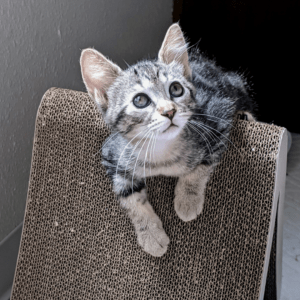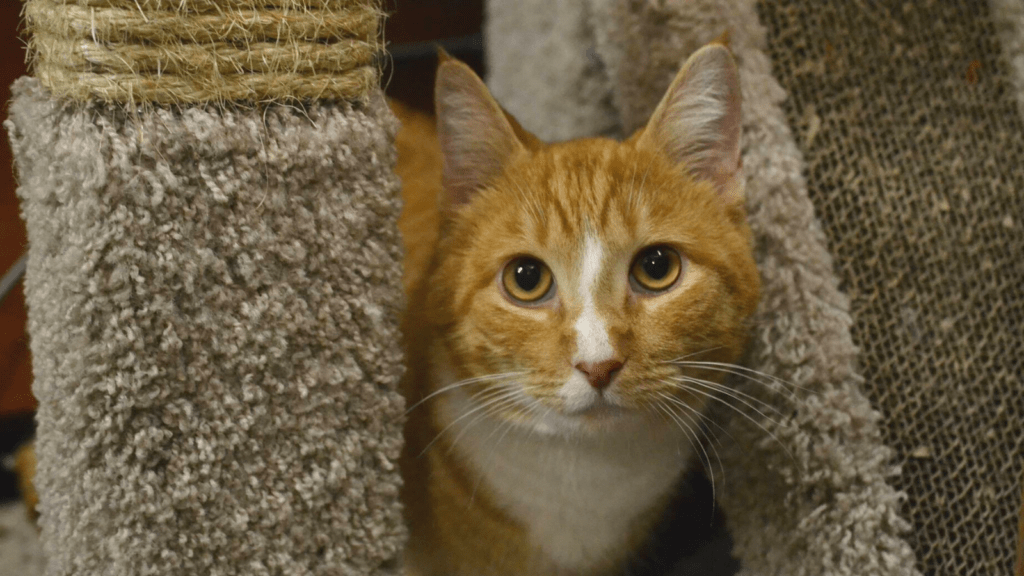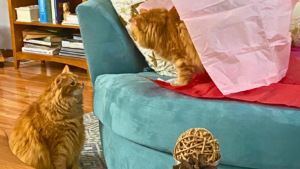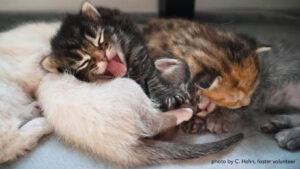Scratching. It’s one of those instinctual cat habits that can be annoying at times and downright destructive at others. But providing safe outlets for your cat to express this natural desire is important for their well-being.
Why does my cat scratch stuff?
Just like human nails, a cat’s claws will grow unchecked without intervention. Cats scratch to remove the outer layer of keratin on their claws, exposing a new layer underneath to keep their claws in shape. A cat will also scratch to leave their scent and mark territory. For most cats, the act of scratching is a relaxing one and can be done as part of play or leisure.
My cat is scratching in an inappropriate place. What can I do?
Sometimes cats will scratch in an undesirable spot due to lack of other attractive options for scratching in their environment. One way to convince kitty to scratch where you want them to scratch, is to add a variety of enticing surfaces and structures to scratch on. Make these new areas especially desirable by placing some catnip on the scratching surfaces or setting a favorite toy nearby. Don’t forget to put the scratching post or board in an area that’s widely used by your cat so they’ll be more inclined to use it. After all, if you spend most of your time in the living room, but put the scratching post in the laundry room, your cat is unlikely to use it!
If your cat continues to scratch in a place you don’t want them to, you still have options. Make the item undesirable for scratching by placing plastic, double-sided sticky tape (such as Sticky Paws), or sandpaper on the item your cat likes to scratch. At the same time, you can place a new scratching post alongside their old favored spot to provide an obvious alternative. If possible, you can also try removing the chair or other item temporarily.

Cats enjoy scratching surfaces that can give their claws a good workout, including textured fabrics like chenille and tweed. Unfortunately a lot of popular furniture styles today are made with these cat-attractive fabrics. Instead choose furniture with wood or metals legs, and pieces upholstered in microfiber, ultra-suede, or leather, which are less likely to be deemed scratch-worthy by your cat.
What types of scratching enrichment can I provide my cat?
Cat scratching posts, pads, and trees are often made of cardboard, wood, sisal, upholstery/carpet, or a mix of these materials. Most cats enjoy having a tall post that allows them to stretch out fully. You can provide height with a traditional cat post, cat tree, or by hanging a long scratcher from a door knob or handle. There is also horizontal cat furniture made from scratching material for cats that like to lounge while they scratch. Experiment with a few different kinds to find the one that your cat enjoys (and therefore uses!) the most.

This scratching is frustrating. Why can’t I just declaw my cat?
While many people believe declawing is a simple procedure, it actually involves removing or amputating the final bone in each toe as part of the nail removal. Recovery from declawing can be a long healing process for cats. It may also cause long-term health or behavioral problems, such as biting, pain, or avoiding the litter box.
At CAT we strongly encourage alternatives to declawing such as providing training and increased opportunities for appropriate scratching, frequent claw trimming, or using cat claw caps.
Will my cat let me trim their claws?
You can absolutely train your cat to accept regular trimming of their claws! Make sure to stay on top of it, keeping them trimmed every 2-3 weeks. You can use cat-safe scissors or clippers specially designed for cats, which are sold at most pet stores and on pet supply websites. Read up on the best techniques and take it slow. It’s okay if you don’t trim every claw their first few times; you want your cat to get used to the feeling. By making trimming a part of your cat’s routine, they will slowly become more comfortable with it. Make sure to encourage your cat by giving them treats, affection, or play time afterward as a reward!
With a little bit of effort, it’s entirely possible to give your cat opportunities to perform natural scratching behavior, while avoiding scratched furniture or other items, And that’s a human-animal win-win!







